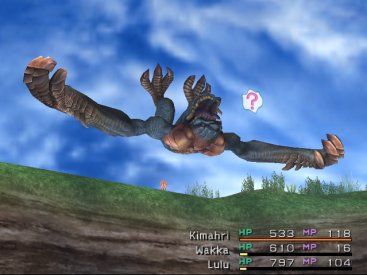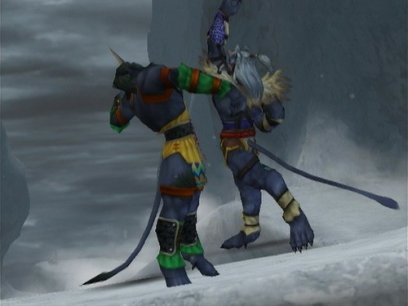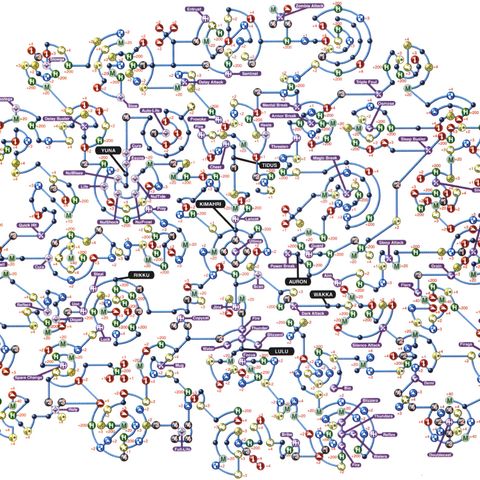In the beloved Final Fantasy X (now on Nintendo Switch, thank Yevon!), the sphere grid acts as a stat and ability tree of massive scale. Every character starts at a position in the sphere grid and as they gain experience (called SP) they can move around the grid collecting stats and abilities along the way.
I’ve loved the idea of the sphere grid for a while. It has its usability flaws, but the influences on the overall game design are positive and facilitate the type of gameplay Square wanted to make. It is one of the critical forces in keeping players engaged throughout the game and subsequent playthroughs.
Let’s analyze how well the sphere grid supports the game design as well as the usability problems that keep it from being as excellent as it could be.
It keeps new players safe
The sphere grid gives an illusion of choice for the most part. At first, it looks like you have so many options, but for the most part, it’s fairly linear (for six characters).
From a game design perspective, this allows the developers to tailor encounters throughout the main game to tight levels to make fights more interesting because they know what stats and abilities the player should have at each point in the game.
It gives skilled players more options
Experienced players can take more creative paths through the sphere grid. There are tons of options available to you:
- Figuring out which routes may be beneficial and the long-term planning involved is challenging for these players and can often lead to them challenging themselves in battles, as well. The possibility of challenge and control over their destiny keeps them in their flow channel.
- Key spheres allow switching characters into different paths. It can be risky but rewarding.
- Teleport spheres and friend spheres found halfway through the game can add crazy options with tradeoffs to your game.
- One strategy I typically do is stop leveling some characters up at certain points in the grid, usually because I want to take advantage of a lock or teleport. Once I obtain what I need, I can use all of my saved up SP to gain a significant burst of stats and abilities all at once.
- This strategy causes me to struggle for a while because my characters haven’t been progressing while I’ve been saving it up for later.
- A concrete example of this is stopping Yuna from moving at some point, waiting for the first friend sphere. Once you get a friend sphere, teleport her to where Lulu is (preferably when Lulu is at the level 3 magic spheres). You can use her saved up spheres to zoom through the rest of Lulu’s grid obtaining a lot of magic nodes that will make her super powerful for that time in the game. But, since she’s not going down her path anymore, you will miss out on higher level healing spells, so there are tradeoffs.
- (International/Remaster only) The expert grid allows more choices and creative game scenarios for skilled players since all characters start out in the center (much like Kimahri in the standard grid). (Although, in practice, the starting stats are very crucial to a character’s job. It’s almost useless to take Yuna down Auron’s path.)
- Avoiding it entirely – the NSG challenge. Various other challenges can be done with it too, increasing replayability.

The amazingly designed Chocobo Eater rewards high skilled players with key spheres! opening up many options to make progression more interesting.
Kimahri adds safe nonlinearity for all players
Kimahri adds non-linearity into the progression that won’t make it impossible to complete the game, but can still be used to make progression more interesting.
Novice players usually find Kimahri useless. If a player messes him up by taking him along the wrong path, he can end up being one of the weakest members. The great thing for these players: you don’t need him for any of the enemies in the game. Everyone else is built to fight a particular enemy type. Players can complain about him being useless, but it was their choice. (Although the game could make suggestions or something to help new players make good decisions. I’d like to see a sort of novice room/NPC that teaches you useful strategies for the sphere grid).
Skilled players will love Kimarhi because he is in the perfect position to do lots of creative things with the sphere grid. Typically people use him to learn steal/use early in the game. I like to have him steal ASAP, then stop moving to save up SP and using it after I get key spheres and teleport spheres to move him through Yuna and Lulu’s grid. By Evrae, he is usually my best mage. If you want more examples, here’s a great Reddit thread.

Usability Issues
The sphere grid has its fair share of problems, too. Some feel the lack of choice is a problem. I hope after reading the above, you realize that while it’s mostly linear to control the difficulty/strategy of the game, there are plenty of choices you have to make the game more interesting. There are still some players who may prefer an entirely non-linear progression system like FF12’s original license board, but I think many of people’s complaints about the lack of choice stem from the UI. (It’s worth noting that a non-linear progression system would completely disrupt the nature of the battle system and strategy entirely. It wouldn’t even be the same game.)
The real problem with the sphere grid is that the user interface takes so much effort that it can become a hassle to use it just to move your characters along a linear path. It violates some fundamental usability principles for user experience. When all you want to do is move your characters down a straight path, why should it take so long to do what I have to do? Beyond that, even making legitimate choices take a lot of time. In getting my platinum trophy, I spent at least 12-20 hours out of 90 in the sphere grid menu, just leveling up characters in ways I didn’t even need to.
Most of the time it takes stems from micromanaging nodes. In order to activate a sphere node, a character must be on it or next to it and place the appropriate type of red sphere. This is cumbersome and only exists for some questionable post-game decisions and the use of a few special types of spheres. I wonder how much different the game would’ve been if they abandoned the red spheres and just let you auto activate any node you’ve traversed through while having a separate button for activating special types of spheres to a node? I would imagine it would have saved hours for players, while barely changing the game at all.
Post-game has a lot of usability problems too… but let’s not go there yet. (Clear spheres… What were they thinking???)
Relation to theme
One major theme in FFX is the concept of breaking false traditions. I find it interesting that the sphere grid parallels this loosely. In the beginning, most characters are stuck in their section of the sphere grid, much like they are stuck in their beliefs in the story. Gradually throughout the game, as the truths of Yevon are unraveled, you gain more and more capabilities to break people out of their sections, showing that just because we see Rikku as a thief, doesn’t mean we can’t break the traditions that thieves can’t use magic. It’s always good when the progression system supports the theme 🙂
Conclusion
The (mostly linear) structure provided by the Sphere Grid allowed Square to make a well-balanced game because they know low-skilled players won’t mess up too much. But key spheres, special spheres, and Kimahri allow high-skilled and returning players to take advantage of some interesting combinations that change up the gameplay in the mid-late part of the game. It’s a shame the UI is so awful. Other than that, it’s a great example of how to make a linear/non-linear hybrid progression system.

